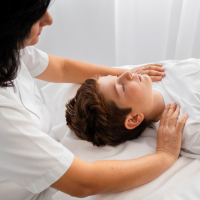
Key message
This review shows that in subacute (medium-term) or persisting neck pain, at closest to 12 weeks follow-up, massage compared to a 'dummy' massage probably results in little to no difference in pain, function-disability, quality of life and participant-reported treatment success. Possible side effects may include treatment soreness.
Background
Neck pain is a common condition in adults leading to acute (< 4 weeks), subacute (4 to 12 weeks) or persisting (>12 weeks) neck pain, disability and substantial economic costs. It may lead to headaches stemming from the neck, referral of pain into the upper back and arms, and signs of weakness or numbness in the arms. It can be affected by bones, joints, muscles, ligaments, tendons and nerves, and be influenced by social, psychological and personal factors.
Massage therapy involves the movement of the soft tissues of the body through manual touch to reduce pain and muscle tension, and promote relaxation. Because massage therapy is commonly used, inexpensive and has minimal side effects, it is of great interest to people with neck pain.
What did we want to find out?
What are the benefits and risks of massage for treating acute, subacute and chronic persisting neck pain in adults with or without arm pain and headache or associated with a whiplash injury? Does the dose (frequency per week, total number of weeks, session duration) of massage influence findings?
What did we find?
We found 33 studies that involved 1994 people suffering subacute and persisting moderate to very strong neck pain including arm pain (6%), whiplash (3%) or headache stemming from the neck (9%). There were no studies addressing acute pain. Studies examined adults aged 18 to 70 years, who were mostly female (70%). Trials were conducted in outpatient settings in Asia, America, Africa, Europe and the Middle East. Funding, when reported (in 15% of studies), was from research centres or universities. We included studies evaluating many massage techniques (with ischaemic compression, a sustained pressure over the soft tissue, being the most common technique) that vary in the manner in which touch is applied, the amount of pressure and intensity that is applied, and session frequency. We did not include techniques that used a massage tool to deliver treatment or non-touch energy techniques.
Compared with a 'dummy' massage treatment, massage probably results in little to no difference in the following:
• Pain (3% improvement): People who had a 'dummy' massage rated their pain at 20.55 points while people who had massage rated their post-treatment pain as 17.12 points. Those who used massage improved by 3.43 points (8.16 better to 1.29 worse) on a 0- to 100-point scale, where a lower score means less pain.
• Function-disability (10% improvement): People who had a 'dummy' massage rated their function-disability at 30.9 points. People who had massage rated their post-treatment function-disability as 21.21 points. Those who used massage improved by 9.69 points (17.57 better to 1.81 better) on a 0- to 100-point scale, where a lower score means better function-disability.
• Health-related quality of life (5% improvement): People who had a 'dummy' massage rated their quality of life at 43.2 points. People who had massage rated their post-treatment quality of life as 37.9 points. Those who used massage improved by 5.30 points (8.24 better to 2.36 better) on a 0- to 100-point scale, where a lower score means better quality of life.
• Participant-reported treatment success (11% improvement): People who had a 'dummy' massage rated their self-reported treatment success at 3.1 points. People who had massage treatment rated their post-treatment success as 2.3 points. Those who used massage improved by 0.80 points (1.39 better to 0.21 better) on a 1- to 7-point scale, where a lower score means more self-reported treatment success.
• Patient satisfaction and serious adverse events - these outcomes were not reported.
• Minor adverse events - minor adverse (unwanted or harmful) events were poorly reported, were the same as with the dummy massage and included minor temporary effects such as mild treatment soreness.
What are the limitations of the evidence?
We have little confidence in our findings that massage provides little to no benefit in terms of pain, function-disability, quality of life and participant-reported treatment success compared to a 'dummy' massage, because it is possible that people in the studies were aware of which treatment they were getting. We believe that these biases may result in either an over or underestimation of the size of the effect reported. The occurrence of adverse events was not commonly reported. The number of participants in most trials was small. Focused planning of studies with larger numbers of participants, adequate massage doses and control for study biases is needed.
How up-to-date is this evidence?
We searched databases up to 1 October 2023.

